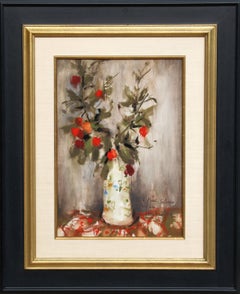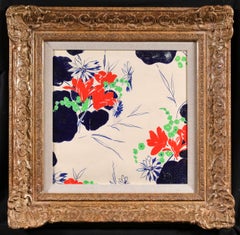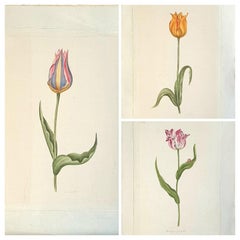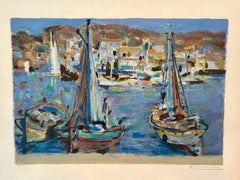Eugene Baboulene Art
to
1
Overall Width
to
Overall Height
to
1
1
1
1
1
1
1
1
9,388
2,689
1,374
1,353
1
1
Artist: Eugene Baboulene
Flower Pot, Impressionist Gouache Painting by Eugene Baboulene
By Eugene Baboulene
Located in Long Island City, NY
Artist: Eugene Baboulene, French (1905 - 1994)
Title: Flower Pot
Year: circa 1960
Medium: Gouache on Paper, signed and dedicated l.r.
Size: 20 in. x 13 in. ...
Category
1960s Post-Impressionist Eugene Baboulene Art
Materials
Gouache
Related Items
Projet de Tissus - Fauvist Flowers Watercolor & Gouache by Raoul Dufy
By Raoul Dufy
Located in Marlow, Buckinghamshire
Botanical watercolour and gouache on paper circa 1920 by French fauvist painter Raoul Dufy. The work depicts flowers in red, blue and green. This work was executed by Dufy as a fabric design.
Dimensions:
Framed: 19.5"x19.5"
Unframed: 12"x12"
Provenance:
Private collection of works by Raoul Dufy for Bianchini Ferier
Bianchini Ferrier Collection - Christie's London - July 2001
SF Fall Show
Raoul Dufy was one of a family of nine children, including five sisters and a younger brother, Jean Dufy, also destined to become a painter. Their father was an accountant in the employ of a major company in Le Havre. The Dufy family was musically gifted: his father was an organist, as was his brother Léon, and his youngest brother Gaston was an accomplished flautist who later worked as a music critic in Paris. Raoul Dufy's studies were interrupted at the age of 14, when he had to contribute to the family income. He took a job with an importer of Brazilian coffee, but still found time from 1892 to attend evening courses in drawing and composition at the local college of fine arts under Charles Marie Lhullier, former teacher of Othon Friesz and Georges Braque. He spent his free time in museums, admiring the paintings of Eugène Boudin in Le Havre and The Justice of Trajan in Rouen. A municipal scholarship enabled him to leave for Paris in 1900, where he lodged initially with Othon Friesz. He was accepted by the École des Beaux-Arts, where he studied under Léon Bonnat, whose innate conservatism prompted Dufy to remark later that it was 'good to be at the Beaux-Arts providing one knew one could leave'.
And leave he did, four years later, embarking with friends and fellow students on the rounds of the major Paris galleries - Ambroise Vollard, Durand-Ruel, Eugène Blot and Berheim-Jeune. For Dufy and his contemporaries, Impressionism represented a rejection of sterile academism in favour of the open-air canvases of Manet, the light and bright colours of the Impressionists, and, beyond them, the daringly innovative work of Gauguin and Van Gogh, Seurat, Cézanne, Toulouse-Lautrec and others. Dufy was an out-and-out individualist, however, and was not tempted to imitate any of these artists. He produced, between 1935 and 1937, Fée Electricité (Spirit of Electricity), the emblem for the French utilities company Electricité de France (EDF).
Dufy visited the USA for the first time in 1937, as a member of the Carnegie Prize jury. In 1940, the outbreak of war (and his increasingly rheumatic condition) persuaded him to settle in Nice. When he eventually returned to Paris 10 years later, his rheumatism had become so debilitating that he immediately left for Boston to follow a course of pioneering anti-cortisone treatment. He continued working, however, spending time first in Harvard and then in New York City before moving to the drier climate of Tucson, Arizona. The cortisone treatment was by and large unsuccessful, although he did recover the use of his fingers. He returned to Paris in 1951 and decided to settle in Forcalquier, where the climate was more clement. Within a short time, however, he was wheelchair-bound. He died in Forcalquier in March 1953 and was buried in Cimiez.
Between 1895 and 1898, Raoul Dufy painted watercolours of landscapes near his native Le Havre and around Honfleur and Falaise. By the turn of the century, however, he was already painting certain subjects that were to become hallmarks of his work - flag-decked Parisian cityscapes, Normandy beaches teeming with visitors, regattas and the like, including one of his better-known early works, Landing Stage at Ste-Adresse. By 1905-1906 Friesz, Braque, Matisse, Derain, Vlaminck, Van Dongen and Rouault were described collectively as Fauves (the wild beasts). What they had in common was a desire to innovate, but they felt constrained nonetheless to meet formally to set out the guiding principles of what promised to be a new 'movement'. Dufy quickly established that those principles were acceptable; moreover, he was most impressed by one particular painting by Henri Matisse ( Luxury, Calm and Voluptuousness) which, to Dufy, embodied both novelty and a sense of artistic freedom. Dufy promptly aligned himself with the Fauves. Together with Albert Marquet in particular, he spent his time travelling the Normandy coast and painting views similar...
Category
1920s Fauvist Eugene Baboulene Art
Materials
Paper, Watercolor, Gouache
$12,702
H 19.5 in W 19.5 in
Botanical Studies, Watercolours on Silk on Handmade Paper, Set of Three Tulips.
By La Roche Laffitte
Located in Cotignac, FR
A set of three fine hand painted botanical watercolour studies on silk of tulips by La Roche Laffitte. The works are signed bottom right. Some are titled and numbered (see photos) Th...
Category
Late 20th Century Eugene Baboulene Art
Materials
Watercolor, Gouache, Handmade Paper, Silk
$1,350 Sale Price
20% Off
H 21.19 in W 15.16 in D 0.04 in
Botanical Studies, Pair of Watercolours on Silk on Handmade Paper, Anemones
Located in Cotignac, FR
A pair of fine hand painted botanical watercolour studies on silk of anemones by La Roche Laffitte. The works are signed bottom right. Both are titled. The silk has been mounted on h...
Category
Late 20th Century Eugene Baboulene Art
Materials
Silk, Watercolor, Handmade Paper, Gouache
$974
H 21.26 in W 15.56 in D 0.04 in
19th Century Italian Wall Paper Painting
Located in Lake Worth Beach, FL
Italian Floral Wallpaper Fragment
19th Century Italian hand painted floral design wallpaper lined with linen, in gold leaf wood frame (as is).
Category
19th Century Italian School Eugene Baboulene Art
Materials
Watercolor, Gouache, Handmade Paper, Linen
19th Century Italian Floral Wallpaper Painting
Located in Lake Worth Beach, FL
Architectural Floral Wallpaper Fragment
19th Century Italian hand painted floral design wallpaper lined with linen, in gold leaf wood framed as is.
Category
19th Century Italian School Eugene Baboulene Art
Materials
Watercolor, Gouache, Laid Paper, Linen
Tulips , White
Located in Zofingen, AG
In this piece, I poured vibrant emotions through acrylic, oil pastel, and colored pencil, blending expressionism, impressionism, and pop art to capture the delicate yet bold spirit o...
Category
2010s Pointillist Eugene Baboulene Art
Materials
Oil Pastel, Acrylic, Archival Paper
Projet de Tissus - Fauvist Still Life Study Gouache by Raoul Dufy
By Raoul Dufy
Located in Marlow, Buckinghamshire
Botanical gouache on paper circa 1920 by French fauvist painter Raoul Dufy. The work depicts a study of apples and pears. This work was executed by Dufy as a fabric design.
Dimensio...
Category
1920s Fauvist Eugene Baboulene Art
Materials
Paper, Gouache
$19,023
H 27 in W 26.75 in
Fleurs et Papillons - Fauvist Flowers Watercolor & Gouache by Raoul Dufy
By Raoul Dufy
Located in Marlow, Buckinghamshire
Botanical watercolour and gouache on paper circa 1920 by French fauvist painter Raoul Dufy. The work depicts flowers in red and butterflies in blues, yellows, black and white. This work was executed by Dufy as a fabric design.
Dimensions:
Framed: 17"x27"
Unframed: 10"x20"
Provenance:
Private collection of works by Raoul Dufy for Bianchini Ferier
Bianchini Ferrier Collection - Christie's London - July 2001
SF Fall Show
Raoul Dufy was one of a family of nine children, including five sisters and a younger brother, Jean Dufy, also destined to become a painter. Their father was an accountant in the employ of a major company in Le Havre. The Dufy family was musically gifted: his father was an organist, as was his brother Léon, and his youngest brother Gaston was an accomplished flautist who later worked as a music critic in Paris. Raoul Dufy's studies were interrupted at the age of 14, when he had to contribute to the family income. He took a job with an importer of Brazilian coffee, but still found time from 1892 to attend evening courses in drawing and composition at the local college of fine arts under Charles Marie Lhullier, former teacher of Othon Friesz and Georges Braque. He spent his free time in museums, admiring the paintings of Eugène Boudin in Le Havre and The Justice of Trajan in Rouen. A municipal scholarship enabled him to leave for Paris in 1900, where he lodged initially with Othon Friesz. He was accepted by the École des Beaux-Arts, where he studied under Léon Bonnat, whose innate conservatism prompted Dufy to remark later that it was 'good to be at the Beaux-Arts providing one knew one could leave'.
And leave he did, four years later, embarking with friends and fellow students on the rounds of the major Paris galleries - Ambroise Vollard, Durand-Ruel, Eugène Blot and Berheim-Jeune. For Dufy and his contemporaries, Impressionism represented a rejection of sterile academism in favour of the open-air canvases of Manet, the light and bright colours of the Impressionists, and, beyond them, the daringly innovative work of Gauguin and Van Gogh, Seurat, Cézanne, Toulouse-Lautrec and others. Dufy was an out-and-out individualist, however, and was not tempted to imitate any of these artists. He produced, between 1935 and 1937, Fée Electricité (Spirit of Electricity), the emblem for the French utilities company Electricité de France (EDF).
Dufy visited the USA for the first time in 1937, as a member of the Carnegie Prize jury. In 1940, the outbreak of war (and his increasingly rheumatic condition) persuaded him to settle in Nice. When he eventually returned to Paris 10 years later, his rheumatism had become so debilitating that he immediately left for Boston to follow a course of pioneering anti-cortisone treatment. He continued working, however, spending time first in Harvard and then in New York City before moving to the drier climate of Tucson, Arizona. The cortisone treatment was by and large unsuccessful, although he did recover the use of his fingers. He returned to Paris in 1951 and decided to settle in Forcalquier, where the climate was more clement. Within a short time, however, he was wheelchair-bound. He died in Forcalquier in March 1953 and was buried in Cimiez.
Between 1895 and 1898, Raoul Dufy painted watercolours of landscapes near his native Le Havre and around Honfleur and Falaise. By the turn of the century, however, he was already painting certain subjects that were to become hallmarks of his work - flag-decked Parisian cityscapes, Normandy beaches teeming with visitors, regattas and the like, including one of his better-known early works, Landing Stage at Ste-Adresse. By 1905-1906 Friesz, Braque, Matisse, Derain, Vlaminck, Van Dongen and Rouault were described collectively as Fauves (the wild beasts). What they had in common was a desire to innovate, but they felt constrained nonetheless to meet formally to set out the guiding principles of what promised to be a new 'movement'. Dufy quickly established that those principles were acceptable; moreover, he was most impressed by one particular painting by Henri Matisse ( Luxury, Calm and Voluptuousness) which, to Dufy, embodied both novelty and a sense of artistic freedom. Dufy promptly aligned himself with the Fauves. Together with Albert Marquet in particular, he spent his time travelling the Normandy coast and painting views similar...
Category
1920s Fauvist Eugene Baboulene Art
Materials
Paper, Watercolor, Gouache
Mid 20th Century Large Paris School Watercolour of a Tablescape
Located in Cotignac, FR
Large, colourful, Mid Century French watercolour of a tablescape by Roger Decaux. Signed bottom left.
Roger DECAUX was born in 1919 in Dombasle sur Meurthe in the Lorraine. He studied art in Paris with Gino Severini and Jan Brusselmans...
Category
Mid-20th Century French School Eugene Baboulene Art
Materials
Paper, Watercolor, Gouache
$1,391 Sale Price
35% Off
H 22.05 in W 29.53 in D 0.08 in
'Pink Daisies', California Watercolor Society, SWA, Woman Artist, Zoltan Szabo
By Beverly Fields
Located in Santa Cruz, CA
Signed lower right, 'Beverly Fields' (American, 20th century) and painted circa 1985.
This listed California artist has exhibited widely and with success and is the recipient of num...
Category
1980s Post-Impressionist Eugene Baboulene Art
Materials
Watercolor, Laid Paper
Still Life
Located in Edinburgh, GB
This drawing by Johann Rudolf Feyerabend, known as Lelong, is a finely executed still life that captures a rustic yet elegant composition. The detailed rendering of objects—such as t...
Category
Late 18th Century Old Masters Eugene Baboulene Art
Materials
Paper, Gouache
Dimitri Berea Still Life
By Dimitrie Berea
Located in San Francisco, CA
Dimitri Berea: 1908-1975. Very well listed Romanian artist with Auction results over $15,000, but sells for much higher in galleries He painted in the post impressionistic style. He ...
Category
1950s Post-Impressionist Eugene Baboulene Art
Materials
Watercolor
Previously Available Items
Sailboats Port Mediterraneen
By Eugene Baboulene
Located in Belgrade, MT
This colorful lithograph is part of my private collections since the 1970's. There is only one print available 6/90. It is artist pencil signed in the lower right corner and numbered...
Category
Mid-20th Century Contemporary Eugene Baboulene Art
Materials
Oil, Lithograph
Eugene Baboulene art for sale on 1stDibs.
Find a wide variety of authentic Eugene Baboulene art available for sale on 1stDibs. You can also browse by medium to find art by Eugene Baboulene in gouache, paint, watercolor and more. Much of the original work by this artist or collective was created during the 1960s and is mostly associated with the Post-Impressionist style. Not every interior allows for large Eugene Baboulene art, so small editions measuring 28 inches across are available. Customers who are interested in this artist might also find the work of Paul Emile Lecomte, Ludovic-Rodo Pissarro, and Henri Edmond Cross. Eugene Baboulene art prices can differ depending upon medium, time period and other attributes. On 1stDibs, the price for these items starts at $4,500 and tops out at $4,500, while the average work can sell for $4,500.



